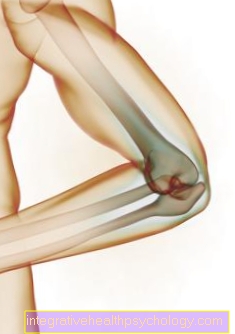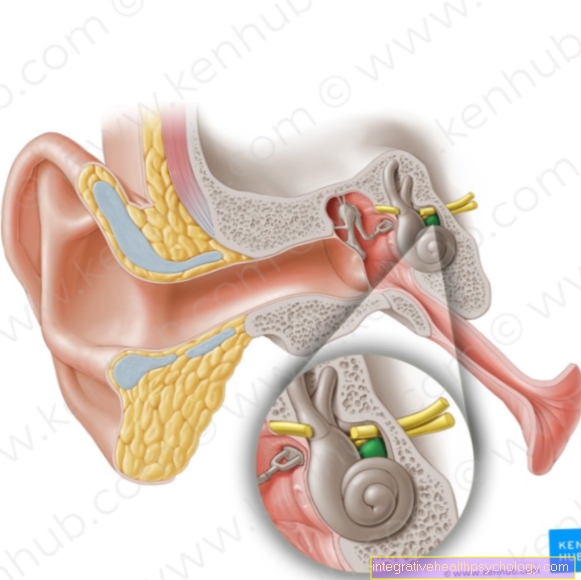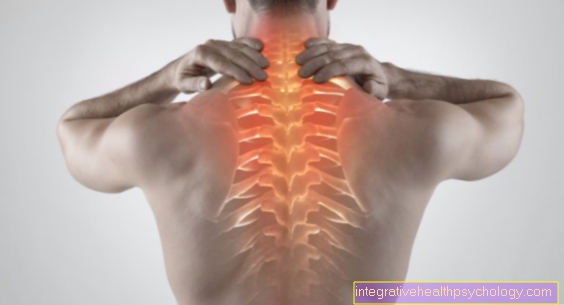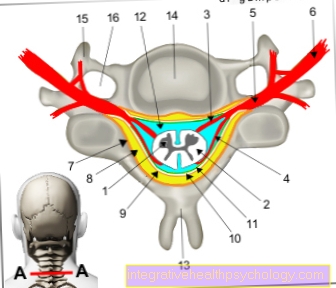Symptoms of angina pectoris
definition
Angina pectoris (literally "chest tightness") usually refers to pain in the chest that occurs in the form of attacks. The reason for this lies in a reduced blood supply to the coronary arteries. In coronary artery disease, for example, these are blocked or narrowed by plaques and therefore cannot be properly supplied with blood.
This results in an insufficient supply of the heart muscle area behind it. This so-called ischemia (insufficient supply of oxygen and other nutrients) can cause pain.

causes
Angina attacks often indicate coronary artery disease. However, it can also have other causes, such as spasms (sudden, brief contraction) of the coronary arteries.
Often, angina pectoris is triggered by exposure to cold, stress, or physical exertion. In such situations, the body's need for oxygen increases. Therefore, more blood has to be pumped into the circulation from the heart than is the case at rest. This increased work of the heart also requires a stronger blood flow to the heart muscles. If this is not guaranteed due to a coronary heart disease, for example, the above-mentioned undersupply of the heart muscles occurs, which can lead to angina pectoris attacks.
Such an attack usually lasts between one and five minutes. The symptoms can be relieved quickly by administering nitroglycerin (often as a "nitro spray").
Angina pectoris can be divided into different stages.
- In stage 0 there are no symptoms despite the occurrence of ischemia.
- Stage I is characterized by chest pain during heavy physical exertion.
- If a slight angina pectoris occurs during normal physical exertion, one speaks of stage II.
- In contrast, in stage III there is considerable chest pain with comparable stress.
- Stage IV is when angina pectoris symptoms occur even with little exertion or complete rest. In such cases, it is usually an unstable angina pectoris in which the underlying disease (usually coronary artery disease) is progressive.
Anyone who suffers from unstable angina has a significantly higher risk of having a heart attack. In the case of stable angina pectoris, however, the symptoms stagnate, which means that the symptoms do not worsen. Although this indicates a stenosis (constriction) of the coronary vessels, it also means that the constriction does not expand any further.
Find out more about the topic here: Coronary heart disease.
Harbingers
The pain in the jaw area can occur weeks to months before the actual form of the angina pectoris. However, these symptoms are very unspecific and should be carefully monitored. The pain in the jaw does not have to be permanent; it can also occur intermittently.
Other harbingers may also appear, such as a general feeling of weakness and fatigue. Often these symptoms are perceived as a kind of flu-like infection.
Before pronounced angina pectoris occurs, pain in the left arm is very common, especially in men. Especially people who know of a family history should see a doctor if this symptom occurs.
Since the harbingers are even more unspecific in women, early detection is correspondingly more difficult.
At the moment, men are affected more often than women. One of the reasons for this is that smoking is a risk factor for coronary artery calcification and a heart attack.
Since men used to smoke more than women, angina pectoris is correspondingly more common in men than in women. However, since just as many women as men smoke these days, an approximation can be expected soon.
Read more about it here: Causes of the development of angina pectoris
Symptoms of angina pectoris
Pain behind the sternum
Pain behind the sternum is the typical symptom of angina pectoris.
Many suffer from pain in the entire chest area, but the pain immediately behind the breastbone is often felt most strongly. Usually the pain is described as dull, stabbing, or piercing. This is usually accompanied by a strong feeling of chest tightness or pressure in the chest. Many of those affected feel as if a heavy sack has been placed on their chest.
In addition to the pain behind the breastbone, there is often a shortage of breath, which is caused by the feeling of pressure.
Also read: Can pain behind the sternum be dangerous?
Left arm pain
Pain that radiates into the left arm is typical of all types of heart disease.
Heart attacks and angina pectoris are particularly associated with pain.Both diseases arise due to a coronary heart disease, in which the coronary arteries are narrowed or blocked and therefore the heart muscles cannot be adequately supplied with oxygen and nutrients.
This mechanism creates pain.
The transmission of pain sensation from the heart to the brain takes place via nerve fibers. These are bundled with many other nerve fibers from different body regions and thus run part of the route to the brain together.
Because of this bundled nerve course, in some cases the brain cannot differentiate from which region of the body the pain originates and it falsely perceives it in the area of the left arm.
In principle, it is also possible to perceive the pain in the right arm, but such complaints occur much less frequently. The reason for this lies in the anatomy of the human body: the heart is on the left side of the chest, so the nerve fibers belonging to it are usually bundled with the other fibers on the left side of the body.
You may also be interested in this topic: Angina pectoris attack
Difficulty breathing as a symptom
Angina pectoris usually manifests itself in the form of chest pain. In addition, there is a feeling of tightness or pressure on the chest. This leads to shortness of breath in many of those affected.
In addition, shortness of breath and angina pectoris symptoms often go hand in hand, as they both occur during physical exertion.
Those who are physically active use more oxygen and therefore have to breathe more. In addition, the muscles in particular have to be supplied with more blood, which is why the heart has to do more pumping work. Heart diseases such as coronary artery disease also develop an oxygen deficiency in the heart, which causes angina pectoris symptoms.
Find out more about this topic here: Difficulty breathing due to a weak heart?
Pain in the upper abdomen
Angina pectoris is usually due to coronary artery disease. The undersupply of the heart tissue causes pain that is normally felt in the chest area. However, they can also radiate into other parts of the body. Adjacent organs are particularly often affected.
While men often focus on chest pain or tightness in the chest, women particularly often complain of stomach or upper abdominal pain. In some cases, upper abdominal pain is the only symptom of angina pectoris. Often the stomach pain is accompanied by nausea and vomiting.
Upper abdominal pain - these are the most common causes.
Symptoms of nausea and vomiting
Angina pectoris attacks are often not only expressed by pain in the chest area. In many cases, the pain spreads to other parts of the body.
Especially in women, the upper abdomen and stomach are often affected. This not only causes pain in the stomach region, but also nausea and vomiting.
Since some people with coronary artery disease experience only nausea, vomiting, and stomach pain without experiencing chest pain or other heart-specific symptoms, angina pectoris should also be considered if the symptoms occur more frequently.
pain in the back
Back pain in general is a common ailment and is usually due to poor posture of the body when sitting.
However, if the back pain occurs in the form of a dull, stabbing or piercing pain, there may be a heart disease behind the symptoms. Back pain in the thoracic spine, in particular, should also be examined for heart disease.
Many people feel a kind of belt-shaped pain that wraps around the chest. Thus, a combination of back and chest pain occurs, which is particularly typical for angina pectoris complaints. While men often report very specific pain behind the sternum, the symptoms in women are much more diverse and unspecific, which is why the diagnosis of angina pectoris can often take longer for them.
If a person suffers from back pain that is attack-like, they should be specifically examined for coronary artery disease. This triggers angina pectoris attacks in many sufferers, which are mostly perceived as chest pain, but often also as back pain.
Pain in the tooth and jaw
The jaw and toothache suggest a real problem in the dental field. However, jaw pain in particular can also be an expression for many other diseases.
In the case of angina pectoris, on the one hand, it is possible that the chest pain also radiates into the area of the jaw and teeth. Sometimes the jaw / toothache can be present without the occurrence of the chest pain.
The jaw pain can also be caused by a general tension in the body. Angina pectoris attacks in particular put the body in a stressful situation. In addition, the seizures are often associated with fear or panic. Among other things, this can cause increased tension in the jaw muscles ("clenching your teeth").
Pain in the throat
Sore throats, as they occur with colds and coughs, are rather an untypical symptom of angina pectoris.
However, the feeling of pain, which is mostly localized in the chest area, can also be perceived in other parts of the body. Chest pain is typically described as stabbing, piercing, or dull. If such a feeling of pain occurs in the neck area, it can also be a sign of angina pectoris
A possible explanation for the origin of this pain lies in the common interconnection of the responsible pain-conducting nerve fibers. As a result, the brain can no longer tell whether the pain originates in the neck or chest area.
Pain in the neck area
Neck pain is rare in angina pectoris symptoms, but it can still occur. They are triggered by the pain radiating from the chest and back to the neck.
One possible explanation for this is that the brain does not have many pain-conducting nerve fibers in the area of the internal organs. This means that the pain cannot be perceived at a specific point. Rather, the feeling of pain arises in a larger area of the body. In some people, therefore, the painful area of the heart extends to the neck. Therefore, the pain from the heart can also be felt in the neck.
In addition, an angina pectoris attack is associated with a stress reaction in the body and can thus lead to reflex tension in the neck muscles. This results in tension in the neck, which in turn can trigger pain.
Anxiety and panic as a symptom
In connection with an angina pectoris attack, a feeling of fear / panic and inner restlessness often occurs.
With increased physical exertion, there is an insufficient supply of the heart muscles. On the one hand, this causes the chest pain known as angina pectoris, on the other hand, it also leads to a feeling of tightness in the chest.
The tightness or pressure on the chest alone can cause fear or panic. It also makes breathing more difficult and thus triggers a feeling of shortness of breath, which in turn can intensify panic. It is because of these mechanisms that the concept of heart anxiety arose, which describes the fear and panic associated with an angina pectoris attack or a heart attack.
Broken sweat as a symptom
People with angina pectoris suffer from heart disease. As a result, they often run out of breath faster during physical exertion and start sweating earlier.
An acute angina pectoris attack can also lead to sudden sweats. These are triggered by the pain in the chest area
Such an attack can also cause fear or panic, which leads to the activation of sweat production in the body.
Symptoms in diabetics
The symptoms of angina pectoris are often less pronounced in diabetics. As with other people affected, the angina usually comes in the form of chest pain, which can spread to the back, left arm and jaw. Stomach pain, nausea and vomiting can also occur.
The increased blood sugar level in diabetics attacks nerve fibers, among other things, so that pain stimuli can only be passed on to the brain to a reduced extent. For this reason, the pain that occurs with angina is less perceived by diabetics.
Because of the loss of nerve fibers, diabetics are more likely to have silent heart attacks, in which a heart attack occurs but no pain is felt.
classification
Different types of angina pectoris are distinguished from one another.
There is, on the one hand, stable angina pectoris and, on the other hand, unstable angina pectoris.
One speaks of stable angina pectoris when the symptoms are similar each time they occur and they last about the same length of time. An example of stable angina pectoris is Prinzmetal's angina, in which there is a spasm of the vessels. Stable angina pectoris usually occurs without any changes in the ECG. This form of angina pectoris can be treated well with nitroglycerin.
In unstable angina pectoris there is either a change in the symptoms or a new onset of angina pectoris. This form is usually based on a heart attack or coronary artery disease on the basis of arteriosclerosis.
The occurrence of unstable angina pectoris is an emergency. In contrast to stable angina pectoris, the basis of unstable angina pectoris is usually visible in the ECG.
Symptoms of stable angina pectoris
The symptoms of stable angina pectoris are particularly characterized by the fact that they do not change over a long period of time.
In general, the disease is primarily associated with chest pain. These are often just behind the breastbone and occur like attacks. They usually last for one to five minutes and can be relieved by administering nitroglycerin (nitrospray).
However, the pain can also radiate to other parts of the body. Back, neck or jaw pain occurs. Pain in the left arm can also be an indication of angina pectoris. In particular, women, and less often men, also experience stomach and upper abdominal pain. This can be accompanied by nausea and vomiting.
In contrast to unstable angina pectoris, the symptoms of stable angina remain constant. Over a long period of time, the symptoms mentioned appear in attacks, the pain does not worsen. These symptoms suggest that a stenosis (constriction) of the affected coronary artery is present, but is not progressing any further.
Symptoms of unstable angina pectoris
The unstable angina pectoris describes the typical pectanginal complaints.
This includes chest pain, especially behind the sternum (breastbone). The pain can also radiate into the upper abdomen and stomach. This is often accompanied by nausea and vomiting. It is also possible to shift the pain to the left arm, the back or the jaw / teeth / neck.
Coronary heart disease is the cause of the pain. So at least one of the coronary arteries is blocked or constricted with plaque.
A worsening of symptoms is characteristic of unstable angina pectoris. Over a certain period of time, several angina attacks occur, which gradually become stronger.
From this one can conclude that the stenosis (narrowing) of the affected coronary vessels is progressing. This is why unstable angina pectoris is associated with a high risk of heart attack.
Any angina pectoris that occurs for the first time also falls under the definition of unstable angina, since in this case the symptoms worsen from “no complaints” to “angina pectoris complaints”.
Find out more about the topic here: Stenosis due to arteriosclerosis.
Symptoms of Prinzmetal's angina
Prinzmetal's angina is also a term for attack-like chest pain. These are triggered by a spasm (sudden contraction) of the coronary arteries.
Similar to coronary artery disease, this leads to a reduced blood flow to the vessels, so that the heart muscles behind the cramping vascular section are no longer adequately supplied with blood. This results in an insufficient supply of oxygen and other nutrients, which in turn leads to chest pain.
These vascular spasms occur like attacks and thereby also cause attack-like pain in the chest area.
Emergency situations with angina pectoris symptoms
If a new angina pectoris symptomatology occurs, it is an emergency!
In this case, an emergency doctor should be called immediately as the situation is life-threatening. Until the ambulance arrives, an attempt should be made to calm the person concerned.
First, the symptoms of angina pectoris are treated and not the causative heart attack, so that the heart can be supplied with oxygen again. The heart attack itself is then treated in the hospital.
But: Not every angina pectoris attack is a heart attack! Especially with stable angina pectoris, which occurs mainly in stressful situations, there is no permanent insufficient supply of the heart muscle. As soon as the exertion is over, the blood vessels are again sufficient to supply the heart with sufficient oxygen.
The unstable angina pectoris, however, is more often a sign of a heart attack.
More on the topic here: Signs of a heart attack.
Differential diagnoses
When the angina pectoris symptoms appear for the first time, most people think of a heart attack first. However, it can also be a ruptured aortic dissection.
The main artery (aorta) consists of three layers. In doing so, the innermost layer in particular can loosen, creating a false cavity (so-called. Aortic dissection). If this cavity, which is filled again and again by the constant flow of blood, ruptures, one speaks of a ruptured aortic dissection.
Just like a heart attack, it is a life-threatening disease which can also trigger angina pectoris symptoms.
Read more on this topic: Aortic dissection
This type of symptomatology does not have to be a life-threatening illness. In some patients, due to the close proximity of the heart and stomach, which are only separated from each other by the diaphragm, an inflammation of the stomach (gastritis) leads to angina pectoris symptoms.
With all these causes it is important to examine the patient as thoroughly as possible in order to rule out a life-threatening illness.
Procedure for angina pectoris
In the event of an angina pectoris attack, a so-called 12-channel electrocardiogram (12-channel EKG) is often written. In addition, the patients usually receive medication that reduces anxiety and pain so that the stressed body can come to rest.
If the person affected knows that his form of angina pectoris is the stable form, he does not have to go to the hospital, as the symptoms usually improve on their own as the stress decreases.
Read more about the topic here: Therapy of angina pectoris.





























